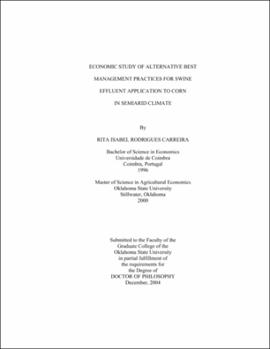| dc.contributor.advisor | Stoecker, Arthur | |
| dc.contributor.author | Carreira, Rita Isabel Rodrigues | |
| dc.date.accessioned | 2013-11-26T08:21:59Z | |
| dc.date.available | 2013-11-26T08:21:59Z | |
| dc.date.issued | 2004-12 | |
| dc.identifier.uri | https://hdl.handle.net/11244/6508 | |
| dc.description.abstract | Scope and Method of Study: The intent of this study was to analyze the economic implications of alternative irrigation systems (subsurface drip water irrigation and center pivot sprinkler irrigation) in Texas County, Oklahoma, a region facing a finite water supply that is declining rapidly and where swine production has rapidly increased in the past 14 years leading to population concerns because of the large amount of swine effluent produced. The basis for the comparison between the two systems was a representative section of land, with one of the quarter sections producing irrigated corn and the remaining sections produced dry-land wheat. The nutrient source for irrigated corn was swine effluent; the production horizon assumed was 100 years. After data were simulated in EPIC, econometric relationships were estimated for several equations: irrigated corn yield, soil nitrogen carryover, soil phosphorus carryover, and nitrogen percolation. A probability distribution for ammonia volatilization was also estimated. The objectives of the study were to evaluate both irrigation systems in terms of soil nutrient accumulation, irrigated corn yield, water use and aquifer life, and expected net revenues over the production horizon. Two types of analysis were performed to compare both systems: a deterministic dynamic programming optimization and a stochastic dynamic programming optimization. | |
| dc.description.abstract | Findings and Conclusions: The estimated relationships had parameters that were consistent which our initial expectations. Based on the results of this study and assuming that it captures producer preferences correctly, SDI is economically more competitive than center pivot irrigation for regions that have similar characteristics to Texas County, Oklahoma, even without considering the current monetary incentives given through the EQIP. The advantage of the SDI is not very big annually, but it is always positive. The lifetime of the aquifer is longest with center pivot as more area is irrigated with the SDI. Producers are advised to seriously consider the SDI as an alternative to CPS when irrigating in the Oklahoma Panhandle. Farmers as well as policy makers should also monitor phosphorus accumulation in soil when effluent is land applied, as the model projected that some accumulation should occur. | |
| dc.format | application/pdf | |
| dc.language | en_US | |
| dc.rights | Copyright is held by the author who has granted the Oklahoma State University Library the non-exclusive right to share this material in its institutional repository. Contact Digital Library Services at lib-dls@okstate.edu or 405-744-9161 for the permission policy on the use, reproduction or distribution of this material. | |
| dc.title | Economic study of alternative best management practices for swine effluent application to corn in semiarid climate | |
| dc.contributor.committeeMember | Epplin, Francis M. | |
| dc.contributor.committeeMember | Hattey, Jeffory A. | |
| dc.contributor.committeeMember | Kizer, Michael A. | |
| dc.contributor.committeeMember | Norwood, F. Bailey | |
| osu.filename | Carreira_okstate_0664D_1141 | |
| osu.accesstype | Open Access | |
| dc.type.genre | Dissertation | |
| dc.type.material | Text | |
| dc.subject.keywords | alternative best management | |
| dc.subject.keywords | swine effluent | |
| dc.subject.keywords | corn | |
| dc.subject.keywords | semiarid | |
| dc.subject.keywords | subsurface drip irrigation | |
| thesis.degree.discipline | Agricultural Economics | |
| thesis.degree.grantor | Oklahoma State University | |
